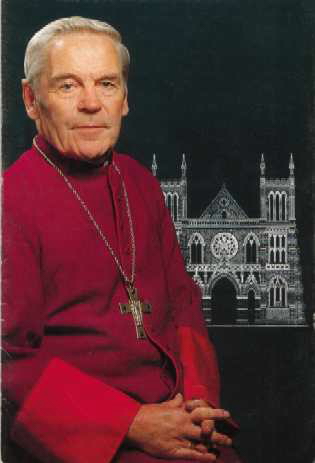
St Joseph's Restoration Project

"a commitment to God's place"
God, our Father, from living stones, your chosen people, you built an eternal temple to your glory.
Increase the Spiritual gifts you have given to your Church.
You entrusted our Saviour to the care of St Joseph's.
By the help of the prayers of St Joseph, may the Church in Otago and Southland continue to grow and to serve the Lord, Jesus Christ, who lives and reigns with you and the Holy Spirit, one God, for ever and ever.
From Bishop Boyle's comment

My dear people,
As I move around the Diocese, it is obvious there is a deep faith awareness that the Parish Church is a place where people draw strength to live their faith.
Like the Parish Church, the Cathedral is a place of great importance. It is the Mother Church of the Diocese, the focal point for the people of Otago and Southland. It would be described as the 'Parish Church of the Diocese. Our present Cathedral has been the 'home' Church for Bishops Moran, Verdon, Whyte, O'Neill, Kavanagh, and myself. Bishop Moran, the first Bishop of the Diocese and the people of his time who co-operated with him in its building proudly built our present Cathedral 106 years ago. At this stage in the life our Cathedral, which we have inherited from past generations, there is urgent need of restoration. As Bishop Moran invited the people of the 1880's to be part of the building of St Joseph's Cathedral. I am now inviting you to join with me in seeing that it is fittingly preserved and restored. As past generations gave us a Cathedral to be proud of, may we, in our times, see our Cathedral fittingly restored. I am pleased the Cathedral is under the patronage of St Joseph's and while this is certainly more than a 'hammer and nails' task, this project is placed under his care.
Yours sincerely in Christ,
+L. A. Boyle
Bishop of Dunedin.

Dear Friends of St Joseph,
St Joseph's Cathedral was opened by Bishop Patrick Moran in 1886. The construction of this ambitious project was funded by the Catholic people of Otago and Southland, and it was completed free of debt.
From the moment of its inception, this impressive and timeless structure has been the very centre of the spiritual life of the Diocese. For successive generations, the Cathedral has been the focus of the Catholic Church in the southern-most Diocese of the world. In addition, this splendid Gothic Cathedral has been, and continues to be, an integral and vital component of the region's architectural heritage.
During the past 106 years, some maintenance work has been carried out, but St Joseph's has now reached a critical point in terms of its preservation. If the Mother Church of our diocesan family is to serve the community for a further 100 years, we must, as a matter of urgency, undertake a comprehensive programme of restoration.
The Diocese does not have the cash resources to carry out this essential and urgent work. After lengthy consideration, Bishop Len and his advisers decided to launch an appeal to raise the necessary funds. I was honoured when the Bishop asked met to act as chairman of the Appeal Committee. I am confident that our diocesan family will meet the challenge just as our forebears did over 100 years ago.
John Farry
General Chairperson

Dear Parishioners,
When Bishop Moran called for donations to build a Diocesan Cathedral, parishioners responded from over the Diocese, now. Bishop Len is asking us to response in a similar manner.
For some time the Board of Economic Administration has been conscious of the need to look after St Joseph's Cathedral. All the advice received tells us that this expenditure will ensure that the Cathedral will continue to serve the Catholics of Otago and Southland for another 100 years.
Over the decades we and our clergy need and have needed this support of the wider Diocese to help establish, maintain and enhance our parish communities, our schools, our common heritage and our future focus.
We appropriately and confidently accept the reciprocal challenge of this appeal as part of our service to Bishop Len and to future generations of Catholics who will be the on-going members of our Diocese.
Ted Cavanagh
The task has begun. . .
106 years ago in 1886, Catholics in the new Diocese of Otago and Southland saw the results of their faith and tremendous generosity in the opening of St Joseph's Cathedral. Designed by F.W. Petre, St Joseph's set out to inspire worshippers, and to witness to the presence of the Church in the young community.
Although never completed to the original design, St Joseph's has continued to serve as the Mother Church of the Diocese; a base for our Bishops to serve their people.
Inevitably, as with all buildings, some maintenance has been necessary over years. Major work was required in 1967 when the flying buttresses were replaced. In 1974 concrete finials were replaced on the towers, and in 1991 saw the Oamaru stone, nave and aisle parapets, which were decaying dangerously, replaced with precast concrete.
Restoration and maintenance planned over the next three years will ensure St Joseph's Cathedral will serve Catholics during the next century.
As well as completing, the sanctuary wall, restoring the high altar, protecting all the stained glass windows, improving physical access, increasing the seating capacity, plans including stablising the front steps. Exterior work includes repointing and replacement of some stonework as well as repairs and maintenance to the roof. The provision of car parking will give level access for worshippers.
With the New Zealand Historic Places Trust A classification, the Cathedral is recognised as an important part of Dunedin City.
St Joseph's Cathedral Restoration
Summary of the need for remedial work
Like all buildings, St Joseph's Cathedral has suffered some deteriorations over the years. The usual life expectancy of a building is about 50 years, given reasonable care and periodic maintenance to preserve its usefulness. Beyond that nominal life, more than routine maintenance is required if the life is to be extended.
These have been few serious problems in the major elements of St Joseph's Cathedral over the 106 years since the Cathedral was first opened. This speaks well for the original design and construction. However, as in all buildings, of whatever construction, some deterioration has occurred and some repairs or replacement of parts have been necessary.
Other that usual levels of maintenance, some replacement work, necessitated by ordinary events like weathering, industrial pollution, earthquakes, and settlement, has been undertaken. All the major work done in the past has been necessary to remove dangerous conditions and to abate risk to people. It included replacement of the flying buttresses (1967), the finials on the front towers, and the parapets on and between these towers (1974), and the nave and aisle parapets (1991). On each occasion the original Oamaru stone, the condition of which had become dangerous, was replaced with concrete, its compatibility with the stone it replaced. This 1991 exercise was part of a larger one involving outstanding significant maintenance issues. The programme for replacement of the parapets was advanced when their condition, potentially dangerous, was identified as acute. The balance of that work programme now needs to be undertaken. This includes completion of repairs to stonework, improvement of some foundations, and securing of the sanctuary wall and window. Once more, this proposed work is required to prevent defects from worsening to the degree where hazards are evident. In addition to repairs required to the structural fabric, work in effecting repairs to ornamentation and other features is required (e.g. stained glass window protection). While all this work is being undertaken, the opportunity is to be taken to effect other repairs and improvements, including the propor termination of the Cathedral where construction was originally halted. The work envisaged is fully described in the report commissioned in 1988. The restoration will complete the total refurnishment in an operation which will prepare the Cathedral for the next century of its life. |

Extracts from New Zealand Tablet - 1884
OTAGO DAILY TIMES, Monday, April 27, 1992

Appeal launched
An appeal to raise $1.5 million for the restoration of St Joseph's Cathedral in Dunedin was launched yesterday.
The chairman of the appeal, Mr John Farry, said the money would be used for the general restoration and maintance of the 106-year-old Roman Catholic cathedral, and some improvements to access.
The cathedral was not only the mother church of the Otago and Southland diocese, but also the home church for the bishop of the diocese.
"Its preservation has a dual purpose," he said.
The planned restoration would mean the church would be for around 100 years. It would also preserve "an intergral part of Dunedin's history".
The Cathedral has an "A classification from the Historic Places Trust, he said.
Mr F. W. Petre designed and built the cathedral. It was opened in 1886 but was never finished" and never will be".
"The original plan envisaged by Petre was three or four times the current size," Mr Farry said.
As well as the restoration, planted areas and paraplegic access would be added to the building and surrounds, he said.
The appeal will run over three years.
April 1996
The Return of the
Original High Altar to St Joseph's Cathedral from old Dunedin
Public Art Gallery.
Click here for more information
OTAGO DAILY TIMES, February 10, 1998
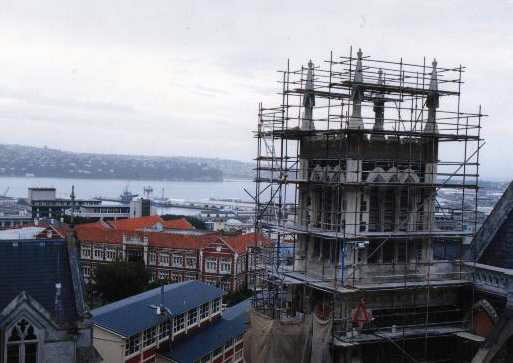
Protective sacking around scaffolding on the north tower of St Joseph's Cathedral is being taken down as stage two of a $1.8 million restoration project nears completion.
Kevin Dale, assistant property consultant with Catholic Property Services in Dunedin, said dismantling the scaffolding would follow and work on lower levels of the tower should be finished by Easter.
It had been difficult and extensive work with much of the Oamaru stone needing to be replaced, Mr Dale said.
Restoration of the cathedral, which was built between 1879 and 1886 in Gothic revival style, started in March last year under the direction of Dunedin architect McCoy and Wixon.
The next stage would probably be the termination, or back end, of the cathedral, the chairman of the restoration appeal committee, John Farry, said.
A storage of finance meant an original cruciform design had never been completed and a temporary rear had served congregations in the cathedral for the past 112 years, he said.
Prohibitive costs meant the cathedral would never be seen with that cruciform design but the back end would be restored and a new sanctuary built.
The fourth stage was restoration of the south tower. A meeting to be held later this week would decide whether this should follow or precede the termination work.
OTAGO DAILY TIMES, Thursday, August 13, 1998

Amid the renovations ... St Joseph's Cathedral appeal and restoration committee chairman John Farry (left) and Bishop Len Boyle discussed progress yesterday.
Renovations see St Joseph's close its door temporarily
St Joseph's Cathedral in Dunedin has closed for the first time in 112 years. The closure would allow a new roof to be put on, the sanctuary to be renewed and level access to be provided to Rattray St, appeal and restoration committee chairman John Farry said yesterday.
The Cathedral would be closed until the work was complete, probably about the end of this year. The job would cost $750,000 and about $150,000 of this was still needed, he said.
Renovation work had started on the historic cathedral a couple of years ago and the north and north tower had been fully restored.
When the cathedral was built, it was supposed to have a spire. Protruding keystones were left at the back of the building. to allow this but it was never built.
A temporary sanctuary was built which had remained for 112 years, Mr Farry said. The latest work would allow the back of the building to meld with the rest.
The main Sunday Mass would be celebrated at Kavanagh College auditorium and other Masses would be held elsewhere.
About $650,000 had been spent on the work already carried out.
After the roof and sanctuary work was complete, the frontage would be finished, the south tower and wall renovated and the interior eventually restored.
About $1.25 million was needed to complete the entire restoration project. A spire would never be built, he said.
Bishop Boyle said the cathedral was built when Dunedin was flourishing in the gold-rush days and any bigger building would now been a burden.
When the cathedral had been renovated years ago, church-goers had been upset to find tarpaulins spread about their place of worship. This had helped prompt the decision to close the cathedral this time.
Before the alternation
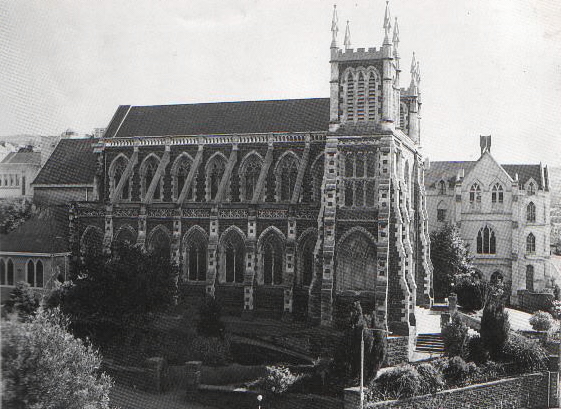
The timber work of the very steep roof over the nave of the Cathedral was solidly constructed under the supervision of Mr D. W. Woods. The timber framing consisted of fourteen Oregon roof trusses of varying sizes and weights, and with other roof framing of Kauri and Rimu. The roofing in of the nave and aisles created a financial problem for Bishop Moran who, up to this stage, with local financial support, had been able to keep out of debt. He decided to appeal to his whole diocese for the extra funds he now needed. In 1884 Monsignor Coleman of Oamaru was appointed to make the Diocesan Appeal. The N.Z. Tablet, now not only acknowledged local efforts for the Cathedral Building Fund, school concerts, pictures of the Cathedral, and weekly contributions, but also the names of people who gave generously to Monsignor Coleman's appeal. Along with parishes came names from smaller districts - Waipori, Skippers, The Branches, Tinkers, Horseshoe Bend, Garibaldi, Moke Creek, Head of Lake, and other places in Otago and Southland. The appeal was a great success. It was a joyful Bishop who could say of Monsignor Coleman in February 1885. "... he has collected three thousand and three hundred pounds over the past year for the Cathedral ... there is no debt on the Cathedral so far, and now I have this handsome sum in hand."
In March, G. S. Williden commenced work on the nave roof with the conventional standard type slates. The two side aisle roofs were done with solid slates eleven feet long, three feet three inches wide, and one inch thick. There were twenty-eight of these slates on each aisle roof. The payment cash book shows that Mr G. S. Wiliden received three hundred and twenty-four pounds for the slate work on he nave and side aisles.
In 1955 the slates on the northern aisle roof were replaced with a protective corrugated iron. Likewise, the slates on the southern aisle roof were replaced in 1972 with corrugated iron roofing. At this stage moisture was leaking through the roof and causing dry rot in the sarking and roof timber. Over the years the original gutters and down pipes by Anderson and Morrison, plumbers and gas fitters, have been replaced.
The roof of the temporary sanctuary seen below the nave roof is galvanised corrugated iron with vertical timber framing.

The brick wall of the temporary sanctuary, with Mr Petre's magnificent Rose Window between the two uncompleted columns at the rear of the sanctuary. It was from the four columns in the temporary sanctuary that Mr Petre had intended building a large tower which, with a spire of ninety-five feet, would reach a height of two hundred feet from floor level. This temporary sanctuary was completed in February 1886, and exteriorly has remained as it was built by Parker and McNamara
This information concerns
'Temporary Sanctuary' was written by Monsignor Peter Mee
on the history of St Joseph's Cathedral for the centennial year
1886-1986
Had St Joseph's Roman Catholic Cathedral in Dunedin ever been completed to the original design of its architect, F.W. Petre, it would have been the biggest cathedral in the Southern Hemisphere.
Such grand plans were able to be contemplated in the late nineteenth century as the Otago region was flourishing in the latter days of the gold rush. Whilst the gold rush came to an abrupt end and ultimately just a quarter of what Mr Petre proposed came to be built, the St Joseph's Cathedral of the late twentieth century is still a structure of impressive proportions.
The cathedral is one of Dunedin's most historically significant buildings and holds the highest classification from the New Zealand Historic Places Trust. It is also currently the focus of a major restoration project, being undertaken in three stages.
The first stage, begun two years ago, involves the restoration of stained glass windows and the building's Oamaru stone block exterior. This work is approximately a third complete, says the restoration project's architect, John McCoy, of McCoy and Wixon architects.
The second stage, incorporating the building of a new roof and the replacement of the cathedral's 'temporary' sanctuary, has recently commenced. Ultimately, the frontage will also be restored, the south tower and wall renovated and the interior refurnished.
Mr Petre's original plan proposed that the cathedral be built in the shape of a cross. What exists, says Mr McCoy, represents just the section of the cross below the junction of the cross's horizontal and vertical beams, known as the transept crossover. On either side of the transept crossover, smaller chapels were intended, whilst an extensive and elaborate sanctuary was planned behind that point.
Rising above the transept crossover was a proposed 200 foot spire and protruding keystones were left at the back of the building to allow for it. Until funds were gathered to complete the spire and the sanctuary, a temporary brick sanctuary was erected. No further building ever occurred, however, and the temporary structure remained until July 1998.
"Obviously," says Mr McCoy, "we can't build the restoration to the original design. But the sanctuary termination is being carried out in a manner which complements Petre's design. The height of the exterior pre-cast panels continues on from the existing cathedral ballustrading to give the appearance that the building has been finished."
McCoy and Wixon has also been involved with the restoration of St Dominic's Priory, and that too holds a New Zealand Historic Places Trust 'A' classification. Whilst the company does a significant amount of conversation work, the practice undertakes a diverse range of work including commercial, residential and educational projects, says Mr McCoy.
All types of work are equally enjoyable, he says, but conversation architecture provides the opportunity to do something "that little bit different."
Those sentiments are echoed by Trevor Hart, the Dunedin area construction supervisor of Amalgamated Builders, which is constructing the new roof and sanctuary terminus. The company, which has branches in Queenstown, Invercargill and Dunedin, deals with a broad range of building work, but he says he jumped at the opportunity to work on St Joseph's Cathedral.
"I find it very interesting work. It is a bit different and it certainly provides a few challenges," says Mr Hart.
Construction workers and engineers had faced, and overcome, a few on-site head-aches, he says. It was discovered that a number of the cathedral's parapets had slumped over the years and that meant that readjustments were necessary with some of the pre-cast panels.
The pre-cast panels, weighing up to 14 tonne, were impressive to look at, says Mr Hart, but manoeuvring them into position required a track crane specifically transported from Christchurch.
The cathedral's status with the Historic Places Trust meant that certain tasks had to be approached from a different perspective.
For example, he says, under typical circumstances the timber framing on the roof would have been replaced before the new slate roof was laid. The historical significance of the framing, however, meant that it had to remain intact.
"This type of work tests the brain, but it is very rewarding in the end," says Mr Hart.
The restoration project has led to the closure of the cathedral for the first time in its 112 year history. It was expected to re-open for services in mid-December 1998.
OTAGO DAILY TIMES, Saturday, October 10, 1998

The renovation of St Joseph's
Cathedral is progressing well, appeal and restoration committee
chairman John Farry says.
The photograph was taken last week, showing a new roof being laid
over the old one and a reconstructed sanctuary at the non-tower
end, with pre-cast concrete having been laid.
Mr Farry said the same slate as
previously used would be put on the new roof.
During renovation of the 112-year-old Dunedin cathedral, present
day building materials had to be used to match the existing
building, he said.
This stage of the restoration is scheduled to be finished by the end of next month, after which the cathedral will open for worship again.
OTAGO DAILY TIMES, Tuesday, December 1, 1998

Work on the interior of St Joseph's Cathedral, in Dunedin, is continuing as part of a $1.25 million restoration programme. Geoff Rodger installs a new lock, while Rob Oram puts up scaffolding behind him. The Roman Catholic Cathedral is closed for the duration of the work, which is expected to be completed by Christmas.
OTAGO DAILY TIMES, Wednesday, December 30, 1998

Renovations at St Joseph's Cathedral in Dunedin should be completed by early February and the historic place of worship again in use.
However, a funding shortfall of $150,000 needs to be found before the next stage of work begins, says parish priest Father Tony Harrison, pictured against the cathedral's refurnished western facade.
The cathedral was closed earlier this year for the first time in its 112-year existence. It re-opened on December 6.
Father Tony Harrison said a new roof and finial were installed and the back wall rebuilt.
An archway made of Oamaru stone was put up around the stained glass rose window and alternations had been made to the cathedral sanctuary and rear entrance.
The north wall and north tower were restored several years ago and the frontage and the south tower and wall were still to be done.
Further funding was needed first, however.
"The next stage is to get enough money to pay for what we have done. At this stage we are $150,000 short. That will impinge on us getting any more work done," he said.
A re-opening ceremony was planned for February 14 next year, on the anniversary of the Cathedral's dedication in 1886.
OTAGO DAILY TIMES, Monday,
February 15, 1998
Cathedral reopened, blessed

The 113 year-old St Joseph's Cathedral on Rattray St reopened last night after $1.5 million of work which included the completion after many years of the sanctuary.
The work which also included the restoration of the northeast bell tower, completes the cathedral in a style sympathetic to the original design by F. W. Petre.
The cathedral's interior was now fully functional and was blessed last night, the Bishop of Dunedin, the Most Rev Len Boyle, said yesterday.
Bishop Boyle said the cathedral was initially never completed due to a lack of funds.
"It ... still had bricks and things sticking out like there was still work to be done - it never looked terminated," he said.
Fund-raising for improvements started about five years ago and the church has been closed for the past six months to allow work to proceed.
Bishop Boyle said the cathedral now had a completed look about it" although more work, such as the restoration of more exterior stonework, remained.
One of the main improvements resulting from work done so far was access to the cathedral, with the addition of a rear entrance, he said.
In the past, the only entrance was up steep steps at the front which were difficult for the elderly and pallbearers to negotiate, he said.
THE TABLET (INCORPORATING THE DIOCESAN NEWS) |
John Farry, Chairman of the Appeal Committee and the St Joseph's Cathedral Restoration Committee, welcomed civic representatives, members of sister Churches, and a large congregation of local Catholics to the reopening of St Joseph's Cathedral on Sunday, 14 February 1999. This date was the anniversary of the opening of the Cathedral in 1886. |
| Mr Farry gave the following address, opening by
observing that 'Without a vision for the people perish'. "Tonight we look to the origin of the vision of this cathedral. It goes back to County Wicklom, Ireland, in 1823 when Patrick Moran was born. He was ordained a priest in 1847 and at the age of 33 he was appointed a Bishop and posted to South Africa, where he remained for 13 years. In 1869 he was appointed to the newly established diocese of Dunedin in New Zealand, and he arrived in the city in 1871. At that time the city was the commerical capital of New Zealand as a result of the gold rush. There was wealth and there was poverty evident in Dunedin at that time. "In a pastoral letter dated 14 January 1873, Bishop Moran wrote to his people: "We may also mention that the time is not far distant when an effort must be made to build a Cathedral in Dunedin that will be worthy of the chief city of the Province and fit to be the Mother Church of the Diocese." The Vision was there, but the people were for the most part very poor Irish immigrants. How was the vision to be converted to a reality? In simple terms it would be done slowly and with patience and tenacity. In 1878 Bishop Patrick Moran, the first Bishop of Dunedin told his people: "We will begin the work. . . we cannot tell who might finish it. . . many years of strenuous effort will be demanded of us." Not only was he a visionary, but he was a prophet of sorts, because indeed he could not have foreseen that it would take 113 years to terminate the building of the cathedral which, of course, would never be finished in accordance with the elaborate plan of F. W. Petre. "The land on which the cathedral was to be build was a deep gully with underground steams. It was purchased for 59 pounds from the Crown. The foundations were driven to a depth of 30-40 feet to the bluestone reef, and there were many technical difficulties. These were overcome by the end of 1878 and the foundation stone of the cathedral was laid on 28 January 1879. "The architect F.W. Petre chose the Gothic style because of the great richness and delicacy of detail". "By 14 February 1886, the major task was partially completed and the cathedral was opened with much fanfare. Several Bishops from Australia and New Zealand were present as well as the mayor of Dunedin and councillors who joined in a procession from the railway station to the cathedral via the Octagon, which was lined with children. The opening concluded with a fireworks display in the evening. "The sculpture and carving were completed by L. J. Godfrey, who was a distinguished London carver who came to Dunedin with his three sons - probably to work on Larnach Castle. The 14 stained glass windows were manufactured in Munich, Germany, and were purchased at a cost of 510 pounds. The 14 Stations of the Cross were manufactured by the same firm at a cost of 130 pounds. "The altar was removed from the cathedral in 1970 to comply with liturgical changes introduced by Vatican II. Thanks to some dedicated Dunedin people it was reassembled at the Art Gallery and remained there until 1996, when it was returned to the cathedral and reassembled at a cost of almost $40,000. "The total cost of the cathedral in its original form was 22,500 pounds. The sanctuary was temporary only, as a transept was to built adjoing the existing building. The tower was to rise to a height of 200 feet above floor level and the completed cathedral was to accommodate 2,000 people. "Obviously it was never to be. The temporary sanctuary was used for 113 years until the present task was embarked upon some six months ago. It has been our privilege to terminate this very important building in the full realisation that it would never be possible to finish it. "An appeal was launched in 1990 and as a result of the great efforts of many people and the generosity of the Catholic population of Otago and Southland we succeeded in raising $1.2 million. The restoration work completed to date, including the present contract, has cost $1.55 million and to complete the task we require a further $1.2 million. "Tonight we celebrate a major event in the history of our city, and I want to pay tribute to the courage, vision and foresight of Bishop Moran and the Catholic people of those distant days. "I wish to pay tribute also to all the Bishops and all the clergy who have served in this cathedral, and also thank sincerely the Catholic people of Otago and Southland for their generosity of spirit which has enabled us to complete this very important task. "I wish to acknowledge the wonderful work of Monsignor Peter Mee in completing the centennial book on the cathedral, which provides all the details relating to the purchase, construction and opening back in 1886. It is a superb effort and a very important historical document. "I wish to thank the Appeal Committee, the Diocesan Development Fund and the Board Economics Administration for the support which has been given to this project. I congratulate and thank the architects McCoy & Wixon, the engineers Hadley & Robinson, Amalgamated Builders Ltd., Dooleys Stone Masons of Oamaru, the restoration architect, Mr Ian Bingham, for reassembling the altar, Kevin Dale and Bill Hayden of Catholic Property Services, and Father Tony Harrison for his forbearance and input during the period when the cathedral has been closed. "Our thanks are due to all the donors who made the sacrifice which enabled us to reach this milestone. "I must also pay special tribute to the major donors - the Community Trust of Otago, the Lotteries Grants Board, and the McMillian Trust, and most importantly I want to congratulate and thank Bishop Len Boyle for his courage, foresight and tenacity in launching the appeal and authorising the Restoration of the Mother Church of the Diocese of Dunedin. |
NZ
CATHOLIC
The national Catholic
newspaper
Sunday, July 4, 1999
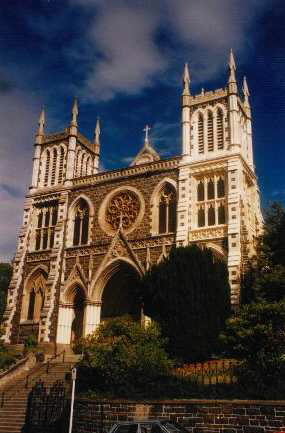
The dark, grimy south tower (left), now the focus of the next stage of restoration, contrasts with the clean north bell tower (right), which was spruced up about a year ago.
Grant enables restoration of cathedral to continue
Further restoration on St Joseph's Cathedral, Dunedin, will proceed following a $200,000 grant from the Community Trust of Otago.
John Farry, chairman of the cathedral restoration committee, said the money would be devoted to restoration work on the southern bell tower at the front of the building. It would include meticulous cleaning of the stonework, refacing damaged stonework and repairs to leadlight windows.
Restoration work already completed, at a cost of $1.5 million, included cleaning and repairs to the north side and the north bell tower, and the completion of the sanctuary and rear of the cathedral.
Work on the south bell tower represents a significant proportion of the estimated $552,800 cost to fully complete the restoration.
The next major stage will involve restoration of the east gable and rose window at the front of the cathedral between the towers.
Work on the south tower will not begin until early next year because stone masons are full occupied with other restoration projects. Once started, restoration work on the tower is expected to take six months.

Restoration of Cathedral's Stations of the Cross
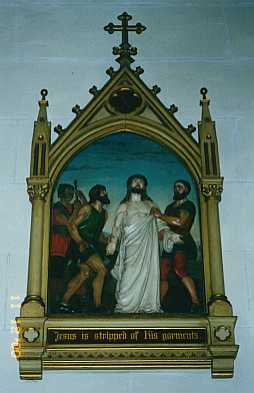
The restored 10th Station
of the Cross
'Jesus is stripped of his garments'
As a result of a generous anonymous donation to the St Joseph's Cathedral Restoration Fund, specialised work is now being carried out on the Cathedral's Stations of the Cross to restore them to their former glory. The donation was made for this express purpose.
The St Joseph's Cathedral Centennial Year Book, written and complied by Monsignor Peter Mee for the centennial in 1986, contains some interesting background information about the stations and the firm which crafted them. With acknowledgement to Monsignor Mee, we reproduce some of that information here:
The Stations, like the stained glass windows of the cathedral, were created in the studios of Franz Mayer and Co., Munich. They were erected in October 1890, replacing the original plain wooden crosses. The figures for each Station were carved in wood and plaster moulds were made of the figures. The plaster casts were then appropriately painted. Each Station is framed in a Gothic arch, supported on a column and surmounted by a wooden cross. The Stations costs 130 pounds.
The firm of Franz Mayer and Co. has been working in stained glass and other art forms since 1848. According to Konrad Mayer (fourth generation), Franz Mayer had a school for disabled children. When their schooling finished about the age of 15, there were no job opportunities for these children, and Franz Mayer founded the Art Studios to provide work for them. It is said that at times as many as 100 young people worked on church furnishings in his studios.
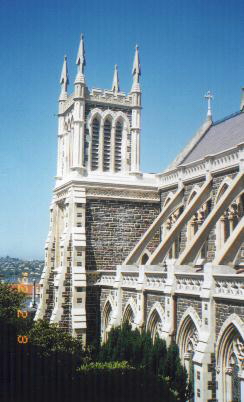
| Home | Author | Bishops | Building | Choir | General | History | Parish | Restoration | the original plans |